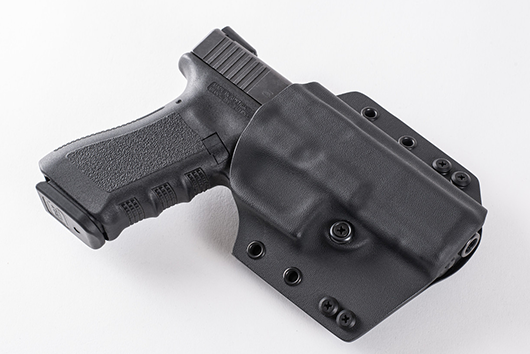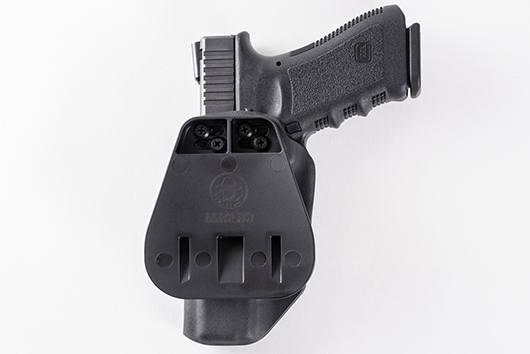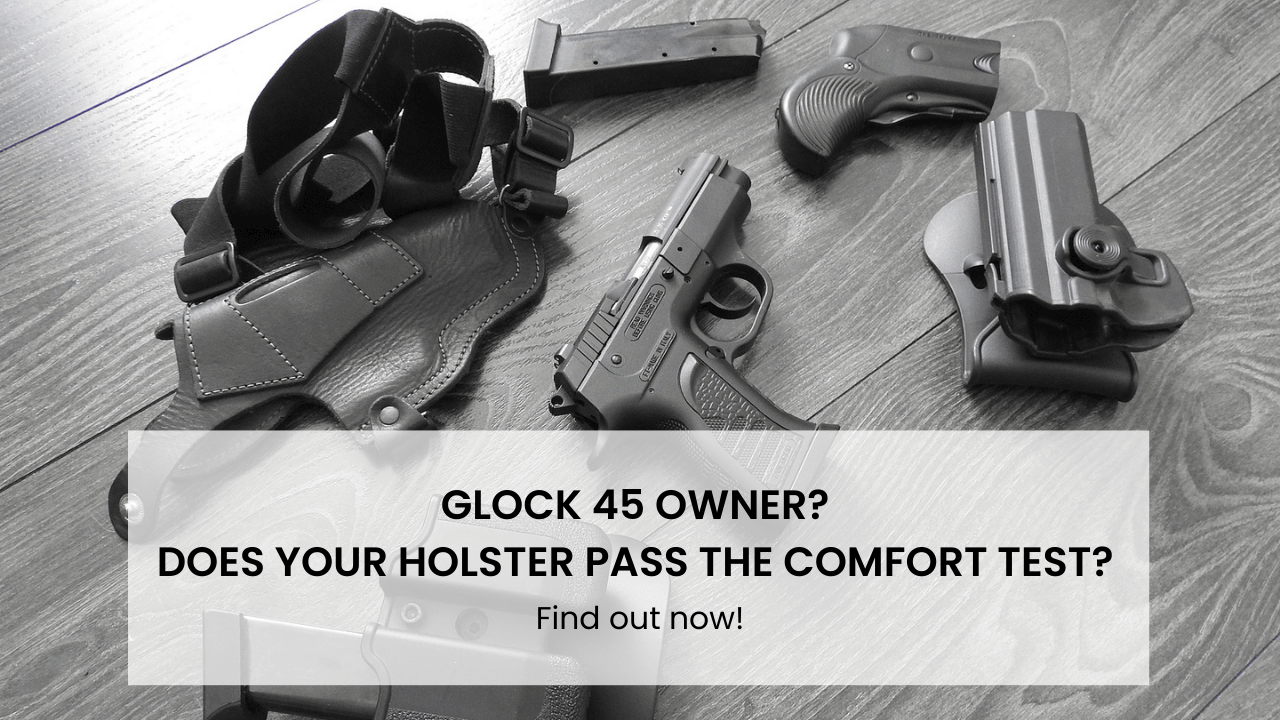Concealed Carry with an OWB Holster
Jul 24th 2020

Most gun owners interested in concealed carrying use traditional inside-the-waistband holsters (IWB). The advantages of this traditional carry solution are well-known: high concealment, minimum printing, and keeping your carry gun close to your body. However, there are also many drawbacks; not every shooter finds IWB carry comfortable, and this carry method limits the gun’s maximum practical size.
OWB carry offers many benefits, such as more comfort and better support for larger handguns. With the proper technique, an OWB holster can be just as effective as an IWB holster for concealment.
Find out everything you need to know about OWB concealed carry, its strengths and weaknesses, and how to effectively conceal-carry with an OWB holster. Then, discover the best OWB holsters on the market and find out how to choose the right one.
What Is an OWB Holster?
An outside-the-waistband holster (OWB) is one of the most common types of gun holster and the counterpart to the inside-the-waistband holster (IWB). While both IWB and OWB holsters are belt holsters, meaning they are designed to be worn on a dedicated gun belt, they are designed differently.
The OWB holster places your gun on the outside of your waistband, making it the closest to classic and historical gun holsters. IWB holsters must be worn inside the pants instead, allowing the pants’ waistband to conceal the firearm.
A typical OWB holster is made of three main parts:
- Holster shell. This shell carries your firearm and can be worn by either a right-handed or left-handed person. It is made from either a single piece of material (taco style) or two layers sewn or riveted together (pancake style).
- Belt clips. One or multiple belt clips allow you to attach the shell to your gun belt, securing the holster to your body. Belt clips can have different sizes depending on your pants’ belt loops.
- Retention screw. An adjustable screw allows you to configure how loosely or tightly the shell retains your handgun. Tune the retention screw to find the right balance between secure retention and ease of pulling the gun.
Can You Conceal OWB?
Unlike the IWB holster, which uses your waistband and a shirt to conceal your gun naturally, the OWB holster is plainly visible when worn by itself. You must use an appropriate cover garment for it to be considered concealed carry.
Fortunately, concealing OWB is not only possible but also relatively simple. To conceal an OWB holster efficiently, you must wear the correct type of cover garment to ensure your gun and holster stay out of view.
If you are used to IWB carrying, you’ll have to remember that since your holster is not inside your waistband, its lower half won’t be naturally hidden. Pick a cover garment that is long enough to cover the entirety of your gun and holster.
Depending on the weather, you can use one of two methods to hide your OWB holster efficiently:
- Loose clothing. During hotter weather, a large, baggy, or flowy cover garment will keep your gun concealed efficiently without overdressing. Loose clothes help hide or break the gun’s outline apart, eliminating or reducing printing. Examples include long shirts, cardigans, light jackets, and dresses.
- Layers. In colder climates, you can wear additional layers to conceal your holster and firearm, preventing them from printing. Clothing like suit jackets, loose or heavy sweaters, jackets, and coats are excellent choices for OWB concealment.
Is OWB Carry Safe?
While all carry methods are generally safe with proper precautions, OWB carry can be considered slightly safer. This is because OWB carry positions naturally place slightly more distance between your gun and your body than IWB positions. In the event of an accidental discharge, the barrel is pointed further away from your body, slightly reducing the risk of injury.
However, newcomers should not rely exclusively on this to be safe while carrying OWB. Always observe the four rules of gun safety and be mindful of your trigger finger, especially while drawing and re-holstering.
Are OWB Holsters Comfortable?
The modern OWB holster follows the same fundamental principles as the earliest handgun holsters. Well-designed gun holsters provide you with a safe and comfortable spot on your body to carry your handgun without causing undue discomfort. This principle should be true regardless of your body type or the gun’s size and weight.
Compared to IWB holsters, OWB models are typically considered more comfortable. They don’t require you to wedge a holster between your body and waistband, making it easier to adapt to your existing wardrobe.
Benefits of OWB Holsters for Concealed Carry
Using an OWB holster for concealed carry has several benefits over other holster types. Here are the main reasons to consider OWB for your concealed carry setup.
- Better suited for larger handguns. Many gun owners prefer to carry mid-sized pistols for concealment instead of smaller compacts and subcompacts. These larger guns are generally easier to aim and shoot accurately and, in the case of semi-automatic pistols, have higher magazine capacities. If this describes your preferences, OWB carry may be the better choice for you.
- Easy accessibility. The more accessible your gun is, the faster you can draw and the better prepared you are for an unexpected situation. Drawing from an OWB holster is easier to practice and can be done faster than drawing from an IWB holster in an equivalent position.
- Comfort in all positions. The OWB holster is an excellent choice for gun owners who spend extended time in a seated position. OWB holsters can be easily readjusted to keep out of the way while seated at an office or while driving. And, unlike IWB and appendix holsters, there is no risk of accidentally pointing the barrel at your own body.
Downsides to Outside the Waistband Carry
While OWB concealed carry holsters offer many advantages, they are not the perfect carry solution for all circumstances. Knowing the downsides and potential drawbacks of OWB carry is necessary for all gun owners to make an informed choice.
- Can’t achieve deep concealment. By nature, OWB holsters cannot be concealed as efficiently as their IWB counterparts. This is because your cover garments must cover the entirety of the OWB holster to be effective. Your pants will naturally hide the lower half of an IWB holster; your cover garments only need to hide the upper half.
You can partially mitigate these disadvantages by using a smaller handgun or reorienting your holster to present a smaller profile. While this approach cannot achieve the same deep concealment as an IWB model, it can help you maximize the concealment potential of your OWB holster.
-
Can be less secure. While wearing your gun on the outside of your pants makes it easier for you to draw, it increases the risk of theft and loss. A thief or an unauthorized person may be more likely to reach for your firearm and pull it out of its holster if it rides outside your pants. If improperly configured, your gun can also be at a greater risk of falling or sliding out of the holster, especially if the retention screw is set too loose.
You can reduce these risks by increasing the retention tightness and using a quality Kydex holster specifically molded around your firearm’s shape.
Choosing the Right Pistol
While the right handgun depends largely on your preferences and experience as a shooter, you should carefully consider which model to pair with your OWB holster.
Experienced gun owners generally recommend using the largest and heaviest pistol you can comfortably handle for shooting, as they are generally the most accurate and lowest-recoiling. You may have noticed that this directly contradicts what the most concealable handguns look like, which are generally the shortest, smallest, and thinnest possible.
Most handguns fall into four broadly-defined size categories: full-sized, mid-sized (compact), subcompact, and micro-compact.
- Full-size. Refers to handguns primarily designed for police or military applications. These models are the largest and heaviest, emphasizing accuracy and, for pistols, magazine capacity above all other factors.
Common examples include the Glock 17, 1911 Government Model, Beretta 92, H&K VP9, Springfield Echelon, and SIG P320 Full-Size.
- Mid-size/compact. Many mid-sized guns are typically smaller versions of full-size pistols. Most have slightly lower magazine capacities and shorter dimensions than full-size models. However, they generally retain high magazine capacities, shooting comfort, and accuracy.
Examples include the Glock 19, SIG P229, SIG P320 Compact, and Smith & Wesson M&P M2.0 Compact.
- Subcompact. Once considered the smallest pistol category available, the subcompact has become one of the most popular choices for concealed carrying. Many subcompact pistols are simply one step smaller than a mid-size and often share a similar platform. Some are purpose-built and offer even slimmer and more comfortable grips.
All subcompacts are generally shorter, have a lower magazine capacity, and have worse ergonomics than mid-sizes or full-sizes. Popular examples of subcompact pistols include the Glock 26, H&K VP9SK, Smith & Wesson CSX, and Springfield XD Subcompact.
- Micro-compact. The main difference between a subcompact and a modern micro-compact is typically width. Most micro-compacts today minimize the handgun’s profile by being as thin as possible, sacrificing some ergonomics to reduce the risk of printing.
Classic micro-compacts, once called “mouse guns,” used small calibers (.32 ACP or smaller) and thin, single-stack magazines to achieve this. Today’s micro-compacts are marvels of engineering chambered in standard defensive calibers and magazines capable of holding 10 rounds or more.
Common examples of modern micro-compacts include the Glock 43X, SIG P365, SIG P365XL, and Springfield Hellcat. Classic single-stack micro-compacts include the Glock 43, Walther PPS M2, and CZ P-10M.
While the right answer generally lies in the middle, remember that OWB holsters allow you to comfortably conceal-carry larger models than their IWB equivalents. If you don’t have a handgun in mind but want to carry OWB, consider a mid-sized or full-sized pistol first. Regardless of your choice, consider adding a mag carrier to your gun belt if you need extra ammunition or a spare to address a potential gun malfunction.

Types of OWB Holsters
Most OWB holsters on the market fall into three categories: the concealment OWB holster, the paddle holster, and the security holster. The best OWB holster depends on your carrying needs and daily duties. Incognito Concealment offers examples of all three, allowing you to carry your favorite handguns safely and securely every day.
- Concealment OWB holsters. Also known as a CCW OWB holster, this type of OWB holster is primarily designed for concealed carry. It is the best OWB holster for shooters who need to carry OWB but want a traditional carrying experience with a gun belt.
An example is the Incognito Concealment Venture, which features a holster shell made of durable, low-profile Kydex sheeting.
- Paddle holsters. A paddle holster is a variation of the standard concealment OWB holster. Instead of featuring standard belt clips, paddle holsters are fitted with a large, rigid plastic paddle with teeth. This design grips the inside of your waistband to secure your gun and holster to your body, allowing you to wear one with or without a belt.
An example of this holster type is the Incognito Concealment ST7-PRO, which features an open-ended, taco-style Kydex shell for ease of cleaning and maintenance.
- Security holsters. A security holster, also called a duty holster, is a highly durable OWB holster with active retention mechanisms. Unlike other OWB holster designs, security holsters are not designed for concealed carry. They are primarily designed for law enforcement officers, military personnel, security guards, and other armed, uniformed individuals.
Models like the Incognito Concealment Level 2 Duty Holster feature extra-thick Kydex construction and a thumb break retention system. When enabled, a hard loop stops the gun from being pulled up, acting as a security device to protect you from potential thieves.
How to Draw OWB
The standard draw stroke from a concealment OWB holster worn on the 3-o’clock position is as follows:
- Prepare. Start standing with your arms at rest in a neutral position.
- Reveal. With your off-hand (left hand if you are right-handed), push the cover garment out of the way to reveal the OWB holster. Depending on your current outfit, this can mean lifting a long shirt, opening a jacket, or pulling a coat aside.
- Grip. With your dominant hand (right hand if right-handed), reach for the grip of your firearm. Get a firm, tight hold, with your hand positioned as high on the grip as your handgun will allow.
- Pull up. Once you have a firm grip, pull the handgun straight up. Don’t try to rip the handgun out of the holster or at an angle; your gun should come out naturally with one straight upward motion. If it won’t come out easily or if you pull the holster along with the gun, adjust the retention screw to a looser setting.
- Drive down. Once the gun is fully out of the holster, drive your elbow down without moving your wrist to naturally rotate the barrel forward.
- Join hands. At this point, your firearm should be pointed in the direction of the threat. In an emergency, you may shoot immediately. Otherwise, push your dominant hand forward while bringing your off-hand over it, forming a two-handed grip. This should allow you to aim down the sights and take accurate shots. You are ready to shoot.
Remember that you may be slower or fumble specific steps in a life-threatening situation. Regular practice and a solid understanding of these principles are necessary to minimize the risks.
Shop High-Quality OWB Holsters at Incognito Concealment
Incognito Concealment carries a complete range of OWB holsters for concealment and duty use. Our gun holsters are compatible with hundreds of pistol and revolver models from numerous manufacturers, from Beretta and Glock to H&K, SIG Sauer, and Smith & Wesson. Our limited lifetime warranty covers all our holster products.
Do you have any questions or special requests? Contact us today—we’re always here to assist with your holster or concealed carry needs.











